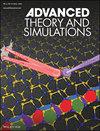以Davidson‐Cole模型为核的松弛时间广义分布函数
IF 2.9
4区 工程技术
Q1 MULTIDISCIPLINARY SCIENCES
引用次数: 0
摘要
许多物理现象,如电介质和粘弹性材料的极化,或多孔电极/电解质界面,不能通过单一的Debye型弛豫时间来建模。为了解释这一事实,通常使用基于德拜松弛时间(DFRT)分布函数的数据分析。在这项研究中,提出了一个广义的DFRT,将Davidson‐Cole模型作为一个基本过程,而不是标准的Debye模型。然后可以从广义Stieltjes变换的逆中检索到分布函数,用迭代拉普拉斯变换表示,应用于给定的频率函数。对于一些最著名的阻抗(或导纳)模型,包括恒相元件、Davidson‐Cole、Havriliak-Negami和Kohlrausch-Williams-Watts模型,导出了广义DFRT的可计算解析表达式。除了通常的等效电路建模方法外,所获得的分布将对使用数值方法解释和与反频域数据进行比较有价值。提出的理论和结果可以很容易地转化为其他物理系统,已知表现出局部频散特征。本文章由计算机程序翻译,如有差异,请以英文原文为准。
Generalized Distribution Function of Relaxation Times with the Davidson‐Cole Model as a Kernel
Many physical phenomena, such as the polarization of dielectrics and viscoelastic materials, or porous electrode/electrolyte interfaces cannot be modeled by a single relaxation time of the Debye type. To account for this fact, data analysis based on distribution functions of the Debye relaxation times (DFRT) is conventionally used. In this study, a generalized DFRT is proposed considering the Davidson‐Cole model as an elementary process instead of the standard Debye model. The distribution function can then be retrieved from the inverse of the generalized Stieltjes transform, expressed in terms of iterated Laplace transforms, applied on a given frequency function. Computable analytical expressions of the generalized DFRT are derived for some of the most known impedance (or admittance) models including the constant phase element, the Davidson‐Cole, Havriliak–Negami and the Kohlrausch–Williams–Watts models. The obtained distributions will be valuable to interpret and compare with inverted frequency‐domain data using numerical methods, in addition to the usual way of equivalent circuit modeling. The proposed theory and results can be easily translated to other physical systems that are known to exhibit local frequency dispersion features.
求助全文
通过发布文献求助,成功后即可免费获取论文全文。
去求助
来源期刊

Advanced Theory and Simulations
Multidisciplinary-Multidisciplinary
CiteScore
5.50
自引率
3.00%
发文量
221
期刊介绍:
Advanced Theory and Simulations is an interdisciplinary, international, English-language journal that publishes high-quality scientific results focusing on the development and application of theoretical methods, modeling and simulation approaches in all natural science and medicine areas, including:
materials, chemistry, condensed matter physics
engineering, energy
life science, biology, medicine
atmospheric/environmental science, climate science
planetary science, astronomy, cosmology
method development, numerical methods, statistics
 求助内容:
求助内容: 应助结果提醒方式:
应助结果提醒方式:


